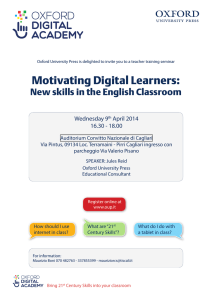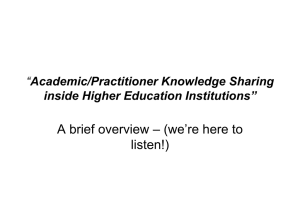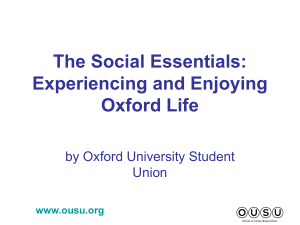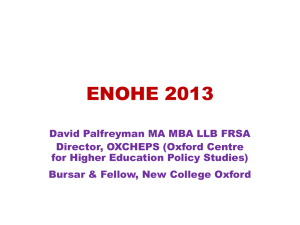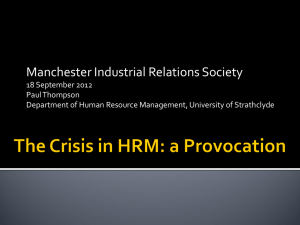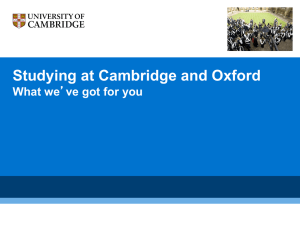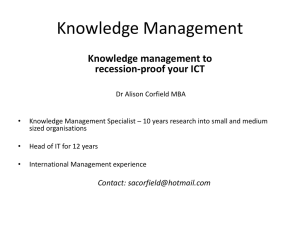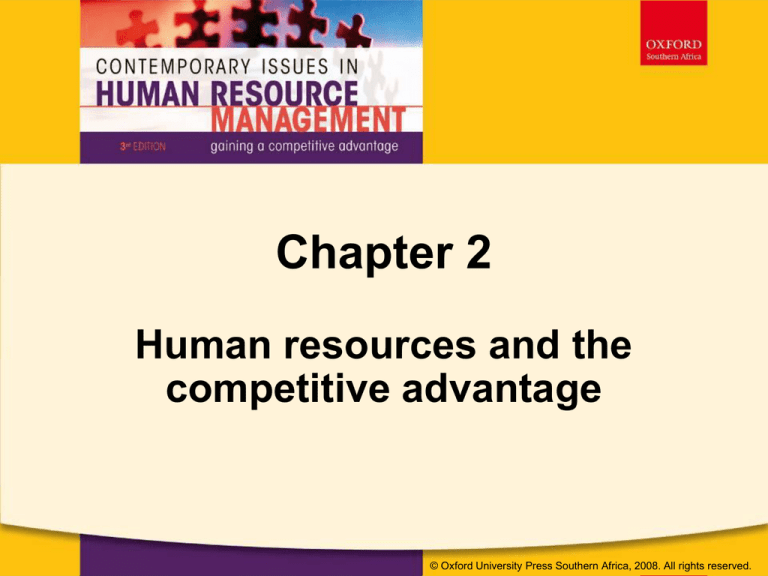
© Oxford University Press Southern Africa, 2008. All rights reserved.
Chapter 2
Human resources and the
competitive advantage
© Oxford University Press Southern Africa, 2008. All rights reserved.
© Oxford University Press Southern Africa, 2008. All rights reserved.
Learning outcomes
After reading this chapter you should be able to:
• explain what a competitive advantage is
• distinguish between the different sources of
competitive advantage
• discuss the role of human resources within
the competitive advantage paradigm
• discuss the different paradigms that exist
regarding the contribution of human
resources to company performance
© Oxford University Press Southern Africa, 2008. All rights reserved.
Chapter content
•
•
•
•
•
•
Opening case: outsourcing - can it work!
Introduction
The concept of competitive advantage
Sources of competitive advantage
The role of human resources
Paradigms of HR contribution to company
performance
© Oxford University Press Southern Africa, 2008. All rights reserved.
What is ‘competitive advantage’ (CA)?
• Historically: a matter of position, companies occupied a
competitive space and built and defended their market
share
– competitive advantage depended on the area in
which business was located and where it chose to
provide its goods and services
– known as the strategic model
– strategy worked well in stable environment (for large
and dominant organisations)
– with rapid competition appearing, new meaning of
‘competitive advantage’ emerged
© Oxford University Press Southern Africa, 2008. All rights reserved.
What is ‘competitive advantage’?
• Barney defined the term as follows:
A firm is said to have a CA when it is implementing
a value creating strategy not simultaneously
being implemented by any current or potential
competitors.
A firm is said to have a sustained competitive
advantage when it is implementing a value
creating strategy not simultaneously being
implemented by any current or potential
competitors AND when these other firms are
unable to duplicate the benefits of this strategy.
© Oxford University Press Southern Africa, 2008. All rights reserved.
What is ‘competitive advantage’?
• company resources have a major role to play in obtaining
CA
• companies cannot create strategies if they do not utilise
their resources in the process
• Resource-based view (RBV)
– 2 assumptions:
companies within an industry/group may be
heterogeneous to the strategic resources they
control
these resources may not be perfectly mobile
across the industry/group
if this is not the case, companies will be able to retain
a CA only for a very short period and be the first to
utilise their resources in the marketplace to make
this possible
Bundle of resources
© Oxford University Press Southern Africa, 2008. All rights reserved.
Sources of competitive advantage
• the differences in company resources across an
industry will be reflected in the variability in profits
generated by them
• no two companies are alike, because no two
companies have had the same set of
experiences, acquired the same assets and
skills or built the same organisation culture
• each company, therefore, is truly unique
© Oxford University Press Southern Africa, 2008. All rights reserved.
Sources of competitive advantage
industry environment
focus
• sees company
resources as
homogeneous and mobile
across companies in an
industry - companies can
purchase or create
resources held by a
competing company
Traditional view
RBV
company-focused
• resources are not
mobile across
companies and
one cannot
purchase/create
resources held by a
competing company
Four groups of company resources
(Barney)
Resource
Description
financial capital
resources
debt, equity-retained earnings
physical capital
resources
physical technology, machines,
manufacturing facilities and buildings
human capital
resources
knowledge, experience, insight and
wisdoms of employees associated with a
company
organisational capital
resources
the history, relationships, trust and
organisational culture that are attributes of
groups of individuals associated with the
company. A company's formal reporting
structure, explicit management control
systems and compensation policies
© Oxford University Press Southern Africa, 2008. All rights reserved.
Four questions to determine
a resource’s value
• question of value - do a company's resources add
value by enabling it to exploit the opportunities and/or
neutralise the threats in the company's environment?
• question of rarity - how many other companies
already possess the valuable resources?
• question of inimitability - do companies without a
resource face a prohibitive cost disadvantage in
obtaining the resources other companies already
possess?
• question of organisation - is a company organised to
exploit the full competitive potential of its resources?
© Oxford University Press Southern Africa, 2008. All rights reserved.
Strategic fit and flexibility
• Strategic fit - aligning a company strategy and
its resources with the environment, a company
can achieve superior performance
• Strategic flexibility - the ability of a company
to adjust to the changes (when rapid external
and internal changes takes place the strategic
fit becomes more challenging)
© Oxford University Press Southern Africa, 2008. All rights reserved.
How can a company sustain
strategic fit whilst enjoying flexibility
in a competitive environment?
• give a system flexibility within the company which allows
it to create batches of unique products quickly, at a
relatively low cost, as and when required
• transferability makes the flexible system a valuable
resource
• strive to acquire flexible (knowledge) workers and organic
structures in a hypercompetitive environment
• basis for this flexibility can be made possible by installing
a company culture based on creativity and quick
response
© Oxford University Press Southern Africa, 2008. All rights reserved.
HR’s role in gaining a
competitive advantage
• value a company's stock of human intellectual capital
as a way of measuring the contribution of HR to the
company's performance
– RBV
– identify HR's best practices, specify and measure
the bundles of typologies of HR practices
associated with the high performance of labour
– Process approach is anchored in both the
resource-based view and the best-practices
theory, integrating economic considerations
with social legitimacy aspects
© Oxford University Press Southern Africa, 2008. All rights reserved.
Evaluate HR against measures of
sources of competitive advantage
• The value of HR - for human resources to exist as a
sustained competitive advantage they must provide
value to the company
• The rarity of HR - if it is to be a sustained competitive
advantage a resource must be rare
• The inimitability of HR - human resources must be
inimitable to be considered a sustained competitive
advantage
• The substitutability of HR - for a resource to be
considered a sustained competitive advantage it must
not have substitutes
© Oxford University Press Southern Africa, 2008. All rights reserved.
Resource-based view (RBV)
• HR systems can contribute to a sustained competitive
advantage by facilitating the development of
competencies that are company specific
• one of the biggest problems facing the RBV approach
is the possibility of employee turnover
• to limit the damage that can occur as a result of
losses, companies can design and implement
turnover management strategies
• allocation of a bigger portion of the profits to
employees by means of gainsharing or share-options
• a culture of belonging can also be created
© Oxford University Press Southern Africa, 2008. All rights reserved.
Resource-based view (RBV)
• level of interest alignment = motivation of employees
• the degree to which behaviour helps individuals to meet
their goals
• the relevance of each organisational goal to the individual
(individual motivational preferences) - individual goals are
not always in line with organisational goals
• use the concept of interest alignment as a measure of the
correspondence between individual and organisational
goals
• organisational interest alignment can be defined as
"the degree to which the members of the organisation are
motivated to behave in line with organisational goals"
A high level of interest alignment can
be realised at 3 levels of motivation
by 3 interest alignment levers
© Oxford University Press Southern Africa, 2008. All rights reserved.
Motivation levels
• extrinsic motivation level - directly influenced by the
reward system that specifies rewards for a given
behaviour, it also includes issues such as power and
recognition
• hedonic intrinsic motivation level - this is the
enjoyment the individuals experience in completing the
task in the work environment. It can be influenced by
changes in the design of individual tasks and the task
context
• normative intrinsic motivation level - driven by the
goal of engaging in behaviour that is compliant with the
norms and values of the organisation
© Oxford University Press Southern Africa, 2008. All rights reserved.
Interest alignment
•
•
this can be influenced by the socialisation
processes within the organisation
organisations can influence interest alignment
positively through adjustments of the three
interest alignment levers:
1) the reward system
2) the socialisation regime
3) changes to job design
© Oxford University Press Southern Africa, 2008. All rights reserved.
Resource-based view (RBV) - alliances
•
•
•
•
•
RBV have in the past only envisioned companies as
independent entities
Result = only a partial account of company performance was
given
Why? Companies do not only exist in isolation but also form
alliances with other companies
alliance partners can play a significant role in shaping the
resource-based CA of the company through network
resources
network resources = "external resources embedded in the
company's alliance network that provide strategic
opportunities and affect company behaviour and value"
© Oxford University Press Southern Africa, 2008. All rights reserved.
Resource-based view (RBV) - resources
•
•
•
•
•
•
fundamental assumption of RBV (companies must own or at
least fully control the resources that confer competitive
advantage) is incorrect
ownership or control of resources is not a necessary condition
for CA
it is the services that resources provide, not the resources
themselves that generate value for the company
proprietary assumption of RBV prevents an accurate evaluation
of a company's CA
when an alliance is formed, each participating company endows
a subset of its resources to the alliance with the expectation of
generating common benefits from shared resources of both
companies
therefore, each company possesses a subset of shared
resources and a subset of non-shared resources that together
form its complete set of resources
© Oxford University Press Southern Africa, 2008. All rights reserved.
Resource-based view (RBV)
•
•
•
to gain and sustain the CA will depend less on
traditional RBV conditions and more on the relational
capability (a company's capacity to form and maintain
valuable interactive relationships with alliance
partners)
alliances can take different forms (joint ventures,
franchising, long-term marketing and licensing
contracts, reciprocal trade agreements, R & D
partnerships and affiliation in research consortia)
can also include outsourcing partners
© Oxford University Press Southern Africa, 2008. All rights reserved.
Best practices paradigm
• direct relationship between particular HR
approaches and company performance
• evidence is found that certain HR practices can be
related to company performance - such as
compensation, selection and training activities
• bundles or systems of HR practices have more
influence on company performance than individual
practices working in isolation
• there are notable differences across studies as to
what constitutes bundles of 'HR best practices'
© Oxford University Press Southern Africa, 2008. All rights reserved.
Best practices paradigm
• most studies focus on enhancing the skill base of
employees through HR activities - selective staffing,
comprehensive training and broad developmental efforts
like job rotation and cross-utilisation
• promotion of empowerment, participative problem solving
and teamwork
• creating role behaviours (company strategies dictate
certain unique attitude and role behaviours from
employees, and HR practices are the primary means to
make this happen, because role behaviours of employees
are observable and also transferable from one
organisational setting to another, they may be easily
duplicated and may not be an enduring CA)
© Oxford University Press Southern Africa, 2008. All rights reserved.
Best practices paradigm
• the impact of HR practices on company
performance may be further enhanced when
practices are matched with the competitive
requirements inherent in a company's strategic
posture
• this new trend came about with the introduction of
the strategic HR approach
• 3 primary perspectives:
– universal approach
– contingency approach
– configurational approach
© Oxford University Press Southern Africa, 2008. All rights reserved.
Universalistic approach
• Huselid - assumes that there are certain best HRM
practices that will contribute to, for example, increased
financial performance of a company regardless of the
strategic goals of the company
• little work has been done that provides a definitive
prescription as to which HRM practices should be
included in a best-practices system
• work undertaken has either focused on single
organisations like banks or only on single jobs within
organisations, without really considering some other
internal or external influences
© Oxford University Press Southern Africa, 2008. All rights reserved.
Best practices paradigm
• Delery & Doty identified 7 practices consistently
considered to be strategic in nature:
– internal career opportunities
– formal training systems
– appraisal measures
– profit sharing
– employment security
– voice mechanisms
– job definition
© Oxford University Press Southern Africa, 2008. All rights reserved.
Best practices paradigm
• these practices were utilised in several analyses to test
the soundness of the 3 dominant theoretical perspectives
(universal, contingency and configurational)
• results of the analyses provided some support for each of
the 3 perspectives
• theoreticians and researchers have argued that a
contingency perspective is more appropriate to strategic
HRM
© Oxford University Press Southern Africa, 2008. All rights reserved.
Best practices paradigm
• contingency approach
– more appropriate to strategic HRM
– differs from universalistic approach – research
undertaken attempts to links HRM systems and practices
to specific organisational strategies
• closely related body of research calls for a configurational
approach to strategic HRM and argues that it is the pattern
of HRM practices/systems that contributes to the attainment
of organisational goals
© Oxford University Press Southern Africa, 2008. All rights reserved.
Best practices paradigm
• configurational approach argues that the fit of HRM
practices/systems with the company strategy is a vital factor
but that there are specific 'ideal types' of HRM
systems/practices that provide both horizontal and vertical
fit of HRM systems/practices to the organisational structure
and strategic goals
• the configuration of practices/systems that provides the
tightest horizontal and vertical fit with any given strategy
would then be the ideal type for an organisation pursuing
that particular strategy
• horizontal fit refers to the internal consistency of the
organisation's HR policies/practices
• vertical fit refers to the congruence of the HR system with
other organisational characteristics such as the company
strategy
© Oxford University Press Southern Africa, 2008. All rights reserved.
Configurational approach
• the pattern of HRM practices and systems
contribute to the attainment of organisational
goals
• fit of HRM practices and systems is vital
© Oxford University Press Southern Africa, 2008. All rights reserved.
Process paradigm
• anchored in RBV and Best practices theory
• Amit & Belcourt created the theory
• refer to HRM processes as deeply embedded
company specific dynamic routines by which the
company attracts, socialises, trains and motivates,
evaluates and compensates its HR
• company specific HRM processes are established
by developing and exchanging information throughout entire organisation
• organisational learning, creates transfers and
institutionalises knowledge through the
organisation, which increases adaptability
© Oxford University Press Southern Africa, 2008. All rights reserved.
Process paradigm
• HRM processes in a company are revolutionary
• continuously evolving and adapting by drawing on past
experiences to refine the effectiveness of processes and to
meet the changing needs of the organisation
• HRM processes can become one of the company’s strategic
assets if they are able to help realise superior profitability
• HRM processes is an engine of renewal that can be used
continually to adjust the way in which a company selects,
trains, socialises and evaluates its human capital and
enables a company to execute its strategy effectively
• universal adoption of best practices → company
homogeneity as people come and go, but processes remain
and improve the company
• thus, HRM processes are about how things are done
NOT what is produced


